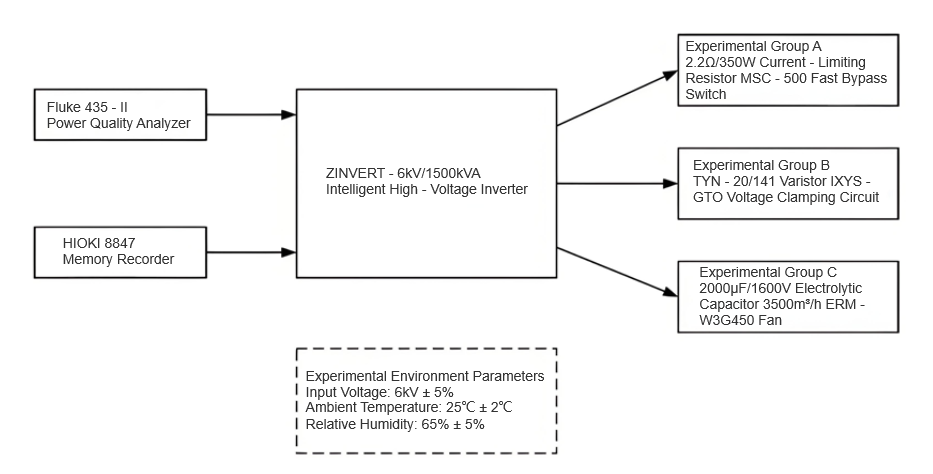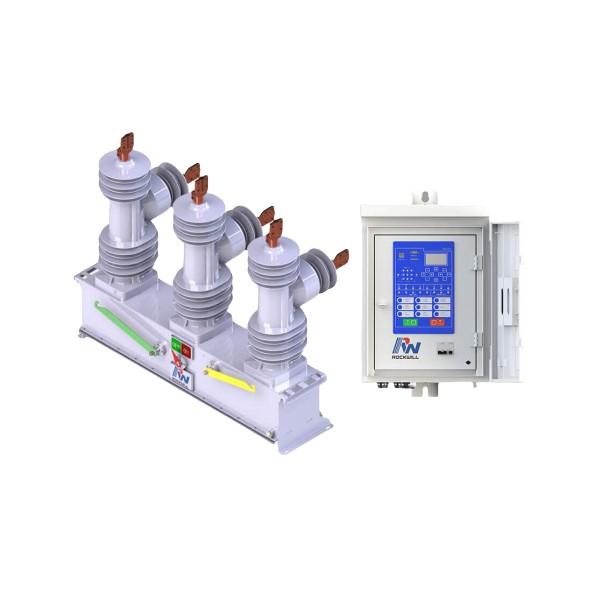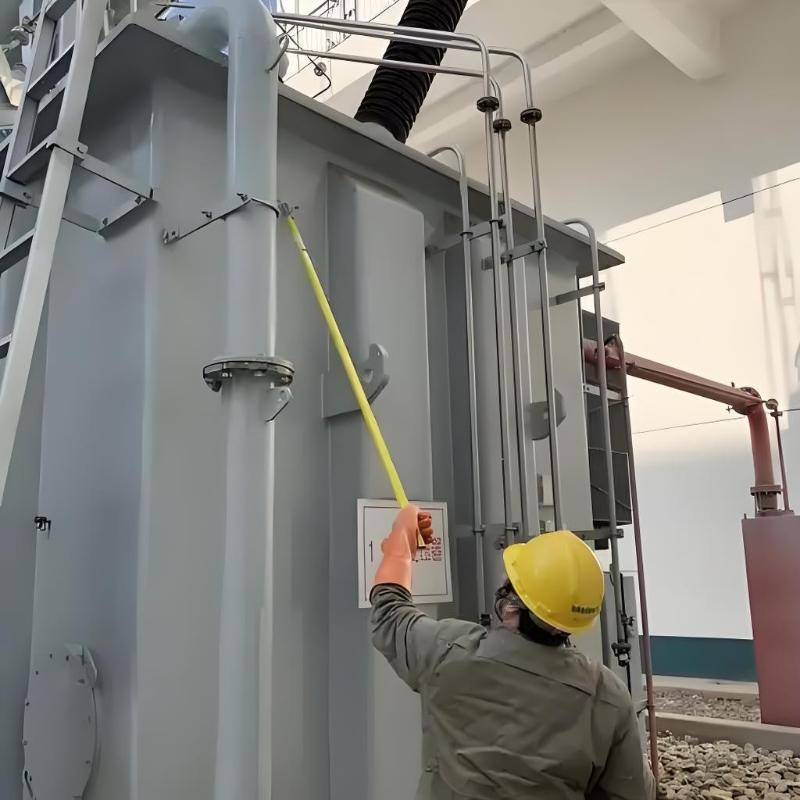Ang mga inverter nga may taas nga boltage mahimong importante kaayo sa pag- kontrol sa bilis sa motor ngadto sa AC ug gi gamit gihapon sa industriya sama sa pag-lift, metallurgy, langis, ug pag-generate sa kuryente. Apan, ang mga 6kV high-voltage inverter kasagaran mag adunay abnormal nga drive tripping faults tungod sa mga factor sama sa grid fluctuations ug load impacts, na nagpapahimulos sa seguridad ug reliability sa sistema sa pag- kontrol sa bilis sa motor.
Arangkada mao ang stable nga operasyon sa mga high-voltage variable frequency drive (VFD) system, pag-improve sa industrial efficiency, ug pagbawas sa pagkonsumo sa kuryente, ang gobyerno miingon og usa ka serye sa mga patakaran nga naghatag og insentivo sa pagtungha ug paggamit sa teknolohiya sa high-voltage inverter. Kini nga mga pag-analisa sa rason sa abnormal nga tripping faults sa 6kV high-voltage inverters ug ang pagbuhat og epektibong preventive measures maoy dako nga importansya aron mapadayon ang pagbutang sa high-voltage VFD technology ug mapatuloy ang ekonomikong paglambo sa industriya.
1 Overview sa 6kV High-Voltage Inverters
Ang 6kV high-voltage inverter usa ka high-power power electronic device nga gigamit og IGBTs isip switching elements ug gigamit og multilevel topology aron makamit ang variable-frequency speed control sa 6kV o mas taas. Ang mga power units niini kasagaran nag-adopt og three-level neutral-point-clamped (3L-NPC) o five-level active neutral-point-clamped (5L-ANPC) circuits, gihimo sa cascading og daghang submodules. Ang matag submodule adunay 6–24 IGBTs ug freewheeling diodes, naggamit og stepped waveform nga may 9–17 levels, na mobati og sine wave human sa filtering.
Ang typical capacity nagranggo gikan sa 3000 hangtod sa 14,000 kVA, ang voltage levels naglakip sa 6kV, 10kV, ug 35kV. Para sa mas taas nga capacity ug voltage requirements, ang modular multilevel converter (MMC) topology mahimong gamiton, diin ang mga submodule gigamit og half-bridge o full-bridge structures, adunay hundreds nga submodules stacked per phase, nag-enable sa voltage levels hangtod sa 220kV ug single-unit capacity hangtod sa 400 MVA, suitable para sa renewable energy grid integration, offshore wind power, ug flexible DC transmission. Ang control strategy sa high-voltage inverters komplikado, kasagaran involving key technologies sama sa carrier phase-shifted modulation, current balancing, sensorless detection, ug field-weakening optimization.
2 Abnormal Drive Tripping Faults sa 6kV High-Voltage Inverters
Sa panahon sa operasyon, ang 6kV high-voltage inverters kasagaran mag trip tungod sa mga abnormalidad sama sa overcurrent, overvoltage, ug overheating. Ang overcurrent faults kasagaran molabay sa startup o sudden load changes, diin ang instantaneous current mahimong mobati og 2–3 times ang rated value. Kon ang current mobati og 1600A sukad pa sa 100ms o 2000A sukad pa sa 10ms, ang inverter immediate block ang IGBTs ug disconnect ang output contactor, triggering hardware protection tripping.
Ang overvoltage faults kasagaran gikan sa grid fluctuations o abrupt load changes. Kon ang DC bus voltage mobati og 1.2 times ang rated value (1368V), ang software overvoltage protection mogamit; kon mobati og 1.35 times (1026V), ang hardware protection direct trip. Ang overheating faults kasagaran molabay sa high-temperature environments o sa prolonged overload operation. Kon ang IGBT temperature mobati og 90°C o heatsink temperature mobati og 70°C sukad pa sa 5 minutes, ang sistema mo-issue og high-temperature warning; direct trip kon ang temperatures mobati og 100°C o 80°C, respectively. Ang common feature sa tanang tulo ka klase sa fault mao ang activation sa self-protection mechanism sa inverter, nga rapid cut off output by blocking IGBTs ug disconnecting contactors, resulta sa phenomena sama sa motor emergency stop ug flashing fault alarms.
3 Preventive Measures
3.1 Current-Limiting Resistor
Arangkada mao ang pag-address sa overcurrent faults, ang usa ka current-limiting resistor mahimong connect sa series tali sa inverter output ug motor. Ang field measurements mosulti nga kon ang 6kV/1500kVA inverter mogamit sa motor nga 380kW o mas dako, ang instantaneous starting current mahimong mobati og 5–8 times ang rated current, mobati og labi sa overcurrent protection setting.
Para mabati ang starting current, ang wire-wound resistor o nonlinear zinc-oxide varistor nga may resistance og 1–3Ω ug rated power og 200–500W mahimong gamiton. Ang latter adunay cold-state resistance og higit sa 100Ω ug mobati gyud kasama ang pagtaas sa current, limiting the peak starting current sa within 2–3 times ang rated value. Human sa motor startup, kon ang inverter output frequency mobati og 40Hz o mas taas ug ang current mobati og less than ang rated value, ang voltage drop across the resistor mobati og less than 50V.
Sa point na, ang bypass contactor shorts ang resistor aron avoid continuous power loss. Kon ang current surges sa startup, kon ang current transformer detect og value nga mobati og 1200A, ang control system mo-issue og warning; kon mobati og 1500A, ang inverter immediate block ang IGBTs ug open ang bypass contactor, reinserting the current-limiting resistor aron rapid reduce current. The bypass contactor then reclosed aron restore normal operation. The entire switching process takes less than 0.5s, effectively suppressing current spikes, ensuring smooth motor startup, and significantly enhancing inverter reliability.
3.2 Voltage Clamping Circuit
Arangkada mao ang pag-address sa overvoltage faults, ang usa ka voltage clamping circuit mahimong connect sa parallel sa DC bus. Kini nga circuit main consists of a metal oxide varistor (MOV), a fast thyristor (GTO), ug a detection circuit. Field data mosulti nga ang software overvoltage protection mogamit kon ang grid voltage fluctuates more than 15% o kon ang load reduction mobati og DC bus voltage nga mobati og 1300V sukad pa sa 20ms.
Arangkada mao ang pag-prevent sa sulod sa faults, ang TYN-20/141 MOV mahimong gamiton, nga may triggering voltage og 1420V, maximum discharge current og 20kA, ug energy absorption capacity og 8800J per unit. Kon ang bus voltage mobati og 1350V, ang MOV magsugyot ug absorb excess energy; kon ang voltage mobati og 1400V, ang GTO triggers, rapid diverting the overvoltage energy into a resistor to restore voltage to a safe level. The detection circuit continuously monitors the bus voltage.
Kon ang voltage mobati og less than 1250V ug mobati og 50ms, ang release signal sent, turning off the GTO ug restoring normal system operation. Kon ang bus voltage mobati og 1400V sukad pa sa 100ms, ang severe overvoltage fault identified, ug ang inverter enters a software lockout state, requiring manual reset before restart. Practice shows that with this clamping circuit, a 6kV inverter can withstand 35% instantaneous overvoltage ug suppress overvoltage sa within 1.05 times the rated voltage within 100ms. The response is fast ug reliable, effectively preventing frequent overvoltage tripping ug significantly improving system continuity ug reliability.
3.3 Current-Sharing Design
Arangkada mao ang pag-address sa overheating faults, ang current-sharing technology mahimong gamiton aron mabati ang heat generation sa critical components sama sa IGBTs ug heatsinks, preventing thermal tripping.
Specific measures include connecting 1–2 electrolytic capacitors sa parallel across the positive ug negative DC bus terminals sa matag power unit. The capacitors should have a capacitance og 1000–2200μF, voltage rating ≥1600V, ug continuous ripple current ≥100A. Kon ang inverter output current mobati og 1.2 times the rated value (e.g., 900A), these parallel capacitors can provide 10%–20% current sharing capability, reducing the actual current through the IGBTs sa 720–810A. Given that IGBT conduction losses proportional sa square of the current, this approach effectively reduces temperature rise.

Sa formula: PCPC is the IGBT conduction loss (W); VCEVCE is the IGBT saturation voltage (V), which has a linear relationship with the current ICIC (A); UηUη is the turn-on voltage of the IGBT (V); KK is the current amplification factor of the IGBT.
It can be seen that after taking shunt measures, the conduction loss of the IGBT can be reduced by 19% to 36%, and the chip junction temperature can decrease by 10°C to 25°C, thus greatly alleviating the heating problem of the inverter.
In addition, install 1 to 2 electric fans in parallel at the inlet and outlet of the inverter heat sink, with a rated air volume of ≥ 3000 m³/h, which can effectively enhance the cooling effect of the heat sink. Set up 6 to 8 temperature sensors inside the control cabinet to monitor the temperatures of various power units, Mother board, IGBT drive board, etc., in real time. When any point's temperature exceeds 65°C, the control system immediately starts the electric fan at full speed and sends a "load reduction warning" signal to the inverter control unit.
If the temperature continues to rise to 75°C and lasts for more than 10 minutes, the system issues an "over-temperature alarm" signal, limiting the maximum output current of the inverter to below 50% of the rated value until the temperature drops below 60°C, at which point the "over-temperature alarm" is lifted.
If any measurement point's temperature exceeds 85°C and the motor current does not drop below 30% of the rated value, the inverter immediately locks out hardware and stops output. To further improve the cooling effect, apply nanomaterials such as graphene or carbon nanotubes on the IGBT heat sinks of each power unit, utilizing their ultra-high thermal conductivity to accelerate the heat dissipation of the IGBT chips, thereby reducing the junction temperature.
4 Effectiveness of Preventive Measures
4.1 Experimental Design
The ZINVERT-6kV/1500kVA intelligent high-voltage inverter was used as the test object, and a grouped control experiment was conducted to verify the effectiveness of the three proposed preventive measures. The experiments were carried out under rated operating conditions (input voltage: 6kV±5%; ambient temperature: 25°C±2°C; relative humidity: 65%±5%). The experiment was divided into four groups: the control group adopted no preventive measures; Group A employed a 2.2Ω/350W current-limiting resistor with an MSC-500 fast bypass switch; Group B used a voltage clamping circuit formed by a TYN-20/141 varistor and an IXYS-GTO connected in parallel, with the clamping voltage set at 1420V; Group C utilized a 2000μF/1600V electrolytic capacitor (Hitachi HCG series) connected in parallel for current sharing, combined with a 3500 m³/h variable-speed fan (EBM-W3G450) for forced cooling.
Each group operated continuously for 72 hours, with key parameters—such as inverter output current, DC bus voltage, and IGBT junction temperature—recorded every 6 hours. Data were collected using a Fluke 435-II power quality analyzer and an HIOKI 8847 data logger. During the experiment, three typical fault scenarios were simulated: inrush overcurrent (8 times rated current / 0.5s), grid voltage fluctuation (+20% / 1s), and full-load operation (ambient temperature 35°C / 2h). The experimental setup is shown in Figure 1.

4.2 Result Analysis
After 72 hours of continuous operation, data from the four groups were collected and analyzed, with results presented in Table 1. The control group experienced tripping under all three fault conditions, whereas the experimental groups with preventive measures demonstrated effective fault suppression. In Group A, the peak starting current was reduced from 7.8 to 2.2 times the rated value, effectively preventing overcurrent tripping.
In Group B, the voltage clamping circuit limited the maximum DC bus voltage fluctuation to 1368V, well below the 1420V protection threshold. In Group C, the combination of current sharing and forced cooling maintained the maximum IGBT junction temperature below 87.5°C, significantly lower than the 100°C tripping threshold. Furthermore, the response time of all three preventive measures was within 100ms, meeting the requirement for fast protection. No false triggering occurred during the experiment, indicating stable and reliable system performance.

5 Conclusion
This study systematically analyzed the causes of abnormal tripping in 6kV high-voltage inverters and proposed targeted preventive measures. Experimental results confirm that the current-limiting resistor effectively controls inrush current, the voltage clamping circuit significantly suppresses DC bus overvoltage, and the combination of current sharing with forced cooling greatly reduces the risk of IGBT overheating, thereby enhancing the overall reliability of the system.
























